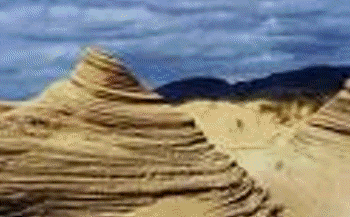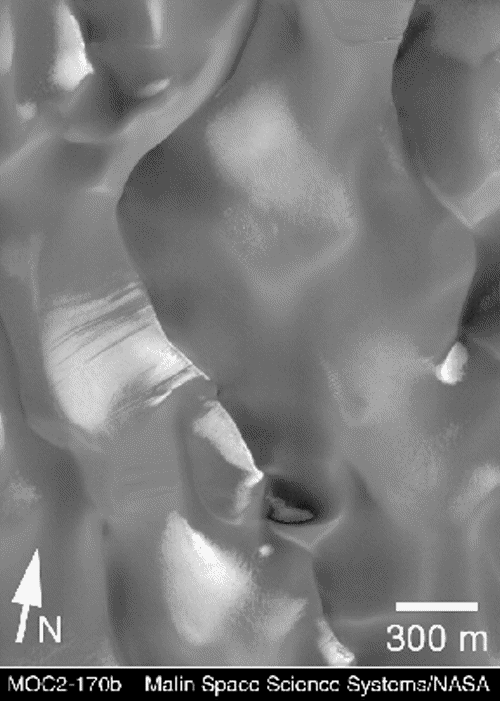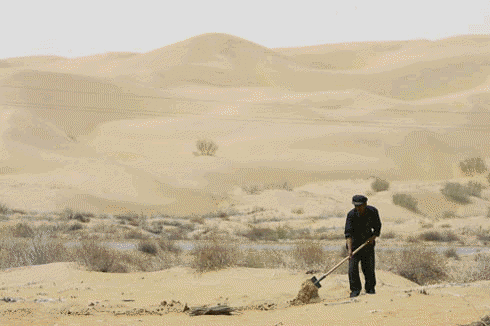
NOVEMBER/DECEMBER 2006
all about sand

| "........
A sand sculpture of a gear box with wheels, linkages, shifter, and robotic arm that plows patterns in the sand at the Texas Sand Fest 2000 in Port Aransas. The sandcastle weathered 40 mph winds on Friday night. |
Physicist solves desert mystery
8 December 2004
From Marco Polo onwards explorers have told stories about strange sounds they have heard in the desert. It is known that the sounds are produced by sand dunes when they avalanche, but the exact mechanism behind the phenomenon has remained a mystery. Now, Bruno Andreotti from the University of Paris-7 has proposed that the sounds come from vibrations in the sand bed that have been excited by collisions between grains of sand (Phys. Rev. Lett. 93 238001).
"Singing dunes are one of the most puzzling and impressive natural phenomena I have ever encountered," says Andreotti. "The sounds produced can be heard up to 10 kilometres away and resemble a drum or a low-flying jet." The sounds can be as loud as 105 decibels and have frequencies between about 95 and 105 Hertz.
The French physicist took his equipment from Paris to the Atlantic Sahara in Morocco, which contains more than 10,000 crescent shaped dunes known as barchans. The wind in the desert can erode the back of these dunes, causing sand to build up at the top of the dune. When too much sand has accumulated, an avalanche occurs and the dunes start to "sing".
Andreotti simultaneously measured vibrations in the sand bed and acoustic emissions in the air, and then extracted information about the frequency, amplitude and the phase of these signals. He found that the vibrations in the sand behaved like slow-moving elastic sound waves that were localized at the surface of the dune and had an amplitude that was about a quarter of the diameter of an individual grain of sand.
"The sounds result from avalanches in which the grains drum on one another, exciting elastic waves on the dune surface, with the vibration of the sand bed tending to synchronise the collisions," he told PhysicsWeb. "In many ways the surface of the sand bed acts like the membrane in a loudspeaker."
Andreotti now plans to study the effect in more detail in the laboratory and with computer simulations. The results could also be relevant to the behaviour of granular materials in general.
About the author
Belle Dumé is Science Writer at PhysicsWeb
..............................................

Shifting
sand dunes on the Hokianga
...The troubled song of the sand dunes
Feature: November 2006
Matthew Chalmers exposes the fierce controversy behind attempts to explain the mystery of “singing” sand dunes, which provides a rare insight into how physics is done
Doing science in the desert is difficult at the best of times. Whether studying its exotic flora and fauna or sniffing out oil wells using sophisticated sensors, researchers have to endure extreme heat and cold, not to mention choking dust and sandstorms. But for physicists who are trying to solve one of the most enduring mysteries of the desert – the eerie phenomenon of “singing” sand dunes – the temperature has been rising for altogether different reasons. Indeed, the disagreement between two French researchers over the mechanism responsible for this weird acoustic effect is so virulent that they can no longer work in the same organization.
On plugging a pair of headphones into a computer to listen to some of their recordings and movies from the Sahara, it is easy to see what all the fuss is about. The low-frequency drone produced by a dune as sand cascades down its face is as unnerving as it is beautiful. It is no wonder that Marco Polo, who was one of the first people to document the phenomenon some 700 years ago, attributed it to evil spirits. A modern traveller, however, is more likely to mistake a singing dune for a low-flying aircraft. For physicists, the challenge of explaining how such a remarkable – and very loud – sound is produced by a simple pile of sand is too tempting to resist. In particular, singing dunes offer the chance to uncover a completely new way of generating sound that is different to the mechanism on which most musical instruments are based. But in rising to this challenge, two physicists and former colleagues in Paris have fallen out bitterly, in an episode that reveals the very human process of developing scientific theories.
Dunes are mounds of sand produced by the action of the wind. Up to hundreds of metres high and existing in a number of different shapes, dunes display complex dynamical behaviour that has kept earth scientists busy for decades. But despite being part of desert folklore for hundreds of years, singing or “booming” sand dunes have remained a mystery.
Singing dunes can be heard in more than 30 locations worldwide, each of which has its own characteristic frequency or note. It has long been known that the sounds – which can last up to several minutes and can be heard more than a kilometre away – come from sand that has accumulated at the top of the dune and that spontaneously avalanches down the dune face. The difficulty has been in explaining precisely how this process can generate such a powerful, monotonous note.
The current controversy surrounding this mechanism can be traced back to 2000, when Stéphane Douady, then at the laboratory for statistical physics at the Ecole Normale Supérieure (ENS) in Paris, heard a geologist talking about his research into the shape and motion of sand dunes. After visiting some dunes in the US, Douady secured funding to work on the problem along with his former PhD student Bruno Andreotti, and the pair was joined by new PhD student Pascal Hersen.
In early 2001 the group set off to explore the physics of crescent-shaped dunes known as barchans in Morocco. But while walking along the dunes one day, the researchers accidentally set off avalanches that were accompanied by loud booms. Having read about this phenomenon in Scientific American some years before, Douady immediately knew what he was hearing. Moreover, based on his research experience with avalanches, he had already come up with his own explanation for the effect based on the “stick–slip” motion of sand grains moving down the slope as a single block. However, faced with the incontrovertible sight and sound of sand grains flowing freely down the dune, he realized there was more to the phenomenon than he had initially thought. “It was exciting to have to come up with a new explanation,” recalls Douady. “Bruno, Pascal and I played on the dunes all afternoon, making sound and trying to find the reason for its creation.”
The first thing the team discovered was that avalanches triggered manually generate exactly the same sound as those that occur naturally, ruling out the role of the wind. Similarly, the researchers realized that the sound was not produced by the whole dune resonating – i.e. in a similar way to how musical instruments produced sound – because its frequency was the same (about 100 Hz) for different-sized dunes. Indeed, Douady found that he could make sounds simply by moving piles of sand with his bare hands. These observations pointed to the same conclusion: the song of the dunes is produced by the motion of the sand grains themselves, and not by global characteristics of the dune.
After seven long days in the desert the team returned to its Moroccan hotel, where Andreotti thrashed out a more detailed explanation for how the motion of sand grains might produce sound. Based on some earlier work he and Douady had carried out on grain avalanches, he expected that the frequency of the sound produced would be inversely proportional to the square root of the grain diameter. But when he plugged in the data, he found that the dunes the team had been studying did not seem to follow this simple model.
The plot thickened when the researchers returned to Paris. Hersen trawled the scientific literature and found about 10 papers relating to the acoustic emission of sand dunes. But despite some articles also predicting that the sound comes from the relative motion of sand grains, none offered a convincing explanation of how this happens. So whenever the researchers found the time in the following months – after all, their main research activity involved the shape of the dunes, not their acoustic properties – they worked on their own explanation for the song of the dunes.
The first thing the team decided was that the frequency of the sound produced is the same as that of the collision rate of grains in the “shear” layer of sand moving down the dune face. Then, recalling a movie made by a colleague that showed aluminium beads collectively switching from a hexagonal to a square arrangement as they flowed down a channel, Douady realized that some of the grains must become synchronized in order to emit sound. Singing dunes, he thought, were the result of air being pushed in and out between the synchronized grains.
Andreotti agreed that the synchronization of sand grains was responsible for the song of the dunes. But rather than being the result of squeezed air, he reasoned that the sound was due to the vibration of the surface of the avalanche – effectively turning it into the membrane of a powerful loudspeaker. Douady eventually accepted that this was a better explanation of the source of the sound – the loudness of which he discovered to his detriment when he buried his ear into a dune face during an avalanche. However, during discussions about the mechanism that actually causes the grains to synchronize, scientific opinions began to diverge.
Douady’s idea was backed up by another observation made during the time in Morocco: sound is only produced when layers of sand above a certain thickness slide over one another. This, he reasoned, means that the sound must arise from a resonance within the shear layer itself, whereby grains bump over each other at the same frequency and set up standing waves that, in turn, synchronize the grains. Andreotti turned this logic round, arguing that the collisions between grains excite waves outside the shear layer on the dune surface that then synchronize the collisions via a mechanism called wave–particle locking.
“The problem with Stéphane’s mechanism”, explains Andreotti, “is that it requires the existence of some sort of coupling wave that travels at speeds lower than 1 m s-1, which is 40 or 50 times less than the measured speed of elastic waves in sand dunes.” Douady says that although it is not yet clear why waves would propagate so much slower in the shear layer than they do in the rest of the dune, he has “similar difficulties” in understanding how random grain collisions in Andreotti’s wave–particle mechanism could excite a coherent wave in the dune in the first place. Realizing that they were asking different research questions, Douady and Andreotti started to work on the problem separately.
In the spring of 2002 Douady gave a brief presentation about his synchronization mechanism at a conference on statistical physics in Paris. This led to an article in the journal of the French national research council (CNRS), which Douady offered to enhance by providing a CD of desert recordings. This was well received and generated lots of media coverage. But Andreotti expressed concerns about releasing interpretations about the source of the song before they had appeared in a peer-reviewed article.
Over the next year or so, the French researchers undertook their own field trips: Douady with Hersen, who had inevitably been drawn into the fight, and Andreotti with a new Moroccan PhD student Hicham Elbelrhiti. Both groups were keen to gather as much data as they could about the speed and volume of sound-producing avalanches so that they could develop their hypotheses about grain synchronization. Andreotti , for instance, reached a proper understanding of the importance of surface elastic modes in the propagation of acoustic waves, while Douady visited dunes at other locations around the world and started to realize that the size of the grains does play a role after all – as do their surface characteristics.
Douady was also keen to reproduce the song of the dunes in his laboratory. So, remembering the way he had made sound with his hands during his first trip, he developed a “moving-blade” experiment in which known volumes of sand can be moved at different speeds in a controlled way. Being able to produce any note desired across an entire octave, this experiment proved that the song of the dunes is produced by the relative motion of the grains and that in fact no dunes are required. Towards the end of 2003, these experiments also enabled Douady to demonstrate the threshold condition vital to his synchronization theory.
Some three or four years after their first trip, it was now time for the researchers to submit for publication the considerable amount of knowledge they had amassed about the song of the dunes. By this time, however, the disagreement between Douady and Andreotti over the synchronization mechanism had intensified.
“Because of the bad relationships, I called a group meeting in spring 2004 during which the overall ENS group leader suggested I write a paper about the song of the dunes with all our names on it,” recalls Douady. “But it soon became clear that this wasn’t going to work.” According to Douady, he found out during this meeting that Andreotti had been making measurements of the velocity of elastic waves during his field trips that contradicted Douady’s synchronization mechanism, although Andreotti insists that his work was no secret. So Douady wrote a draft paper without any mention of Andreotti’s measurements.
Refusing to put his name to an explanation he did not believe, Andreotti decided to publish his own paper on the subject of singing dunes. And shortly afterwards the pair separated for good, with Andreotti joining the laboratory for hydrodynamics and mechanics at the Paris research centre the ESPCI – just one street away.
The story of how their respective papers got published is interesting in its own right. After having an initial draft rejected by Science, Douady submitted a polished version of his paper to Nature in December 2004. But it was sent back on the grounds that the subject of singing dunes had already had enough attention, the reason being that Andreotti’s paper had just been published in Physical Review Letters (93 238001). Feeling the need to demonstrate that he had been doing similar work at the same time, Douady immediately posted his paper onto the arXiv preprint server. This, however, turned out to be a mistake, since a few months later another journal called Geology – which had quickly accepted Douady’s submission – rejected it at the last minute on the grounds that it had been published already. The paper finally ended up in the same journal as Andreotti’s earlier this year, minus any mention of the sound velocity (Phys. Rev. Lett. 97 018002).
These days Douady and Andreotti tend to avoid one another, which is not easy when working in such a small field. “This episode has destroyed several years of my life,” says Douady. “But it has also taught me that science can be done in very different ways – either by sudden intuitive jumps that appear to be unjustified, or cautiously and methodically.” Andreotti has also learned from the experience. “I am now more confident than ever that peer review is the best, or least worst, system in which to work,” he says. “When scientists start to use the media to make scientific claims, things start to get troublesome”.
But the stormy tale of the singing dunes does not end here. In fact with two or three other groups about to publish their own explanations of the effect, none of which requires the sand grains to be synchronized, the controversy may well be about to blow up again.
“Neither Douady’s nor Andreotti’s analysis explains why some dunes do not sing,” says Melany Hunt at the California Institute for Technology (Caltech), who together with co-workers has made extensive measurements of singing dunes using techniques such as radar. “Because we have not observed any dependence of the frequency on grain diameter, and because we can physically feel the sound over a large area of the dune, we have concluded that the sound depends on the dune itself and not on individual grains.” In particular, Hunt and her colleagues have found that dunes have a layered structure that they say causes a dune to act as a waveguide, in which certain frequencies are preferentially propagated. “As for Douady’s moving-blade experiment, we don’t agree that pushing sand in this way is the same physical phenomena as what one finds in the desert,” she adds.
Meanwhile, the fight between Douady and Andreotti, which spilled over to other members of their research groups, has not prevented either researcher from continuing to work on the problem. In fact, in Andreotti’s latest work he claims to account for the threshold effect that is so central to Douady’s synchronization mechanism, as well as supporting the Caltech group’s findings (arXiv.org/abs/cond-mat/0601584). Meanwhile, Douady – who is waiting to move into a new lab in Paris for materials and complex systems – is currently trying to understand how the coating of sand grains affects the sound produced. This, he hopes, may explain the hotly debated issue of the low coupling velocity required by his model.
Sand-dune science may not dominate the research-funding agenda, but unravelling the mystery of the singing dunes offers a valuable insight into how science is done. With motivations for tackling particular problems varying between individuals, and personal relationships lying at the core of any scientific research, only the most hardened positivist can claim that science proceeds by some idealistic hypothetico-deductive process devoid of all human influence.
“I’m sure this kind of story is repeated many times in other laboratories around the world,” remarks Douady. “It’s just that most people don’t realize it.” Indeed, 10 or 15 years from now – when researchers have solved the mystery and textbook chapters have been written – the physics of singing dunes will doubtless be recast as the product of a sequence of logical steps, all other accounts having gradually been buried like skeletons in the sand.
About the author
Matthew Chalmers is Features Editor of Physics
World
.......................................
A villager plants trees to try and keep the sand from shifting to other areas of the Hobq Desert earlier this month in northern China.
Plants halt shifting sands
13 November 2006
Physicists in Germany have turned their attention to an age-old challenge facing desert dwellers -- how plants can be used to stop moving sand dunes. The researchers defined equations of motion that describe wind velocities, vegetation growth, sand movement and how the shape of a desert landscape changes as plants grow in it. The result is a "fixation index" that predicts when plants will be successful at halting a dune. This could lead to a better understanding of the dynamics of coastal dunes and predict how these landscapes will evolve over time. (Phys. Rev. Lett. 97 188001).
Although plants are not common in areas with sand dunes, they play an important role in stabilizing the movement of sand and fixing the position of dunes. Indeed, there is often a relentless competition between plants and sand, which has been harnessed for thousands of years by people living in such regions to control the movement of dunes.
Orencio Durán and Hans Herrmann of the University of Stuttgart in Germany developed their equations using scientific observations of sand-dune behaviour in desert regions. For example, scientists have observed that crescent-shaped "barchan" dunes change into parabolic-shaped dunes when colonized by plants. This transformation is thought to be the first step in halting the movement of a sand dune.
The Stuttgart physicists have used the equations to define a "fixation index", ?, which is the ratio between the rate at which a sand dune erodes and how quickly a plant can grow and inhibit erosion. The equations reveal that plants can transform a barchan dune into a parabolic dune when ? has a value less than 0.5 and plant-growth trumps erosion. Conversely, if ? is greater than 0.5, wind-induced sand erosion stops plants from growing and a barchan dune can continue to move.
"Our results will help allow scientists to make long-term predictions (over thousands of years) about how coastal dunes evolve," Herrmann told PhysicsWeb. “They might even have an impact on environmental issues, like how to increase biodiversity." The research may also aid in protecting semi-arid regions that are threatened by desertification processes.
Durán and Herrmann now plan to repeat their calculations with different types of plants and for varying amounts of rainfall. They also hope to actually test their predictions in the desert.
About the author
Belle Dumé is a freelance science
writer based in France

Mulching
for stabilizing the shifting sand dunes
Mulching for stabilizing the shifting sand dunes in Iran
Hormozgan by Directory of Natural Resource Aran &
Bidgole
by:Hosian
molaii
...................................................

Sand dunes on Mars - Can we hear them??
